Fluffy, short-haired, and curly-haired cats are widely loved pets, but there’s a captivating group that stands out with their minimalist look: Hairless Cats. These striking felines can range from having a soft, downy coat to being completely hair-free.
While their bare appearance might suggest they are low-maintenance, hairless cats actually require dedicated grooming and extra protection from environmental elements like sun, heat, and cold.
However, enthusiasts of these unique beauties will tell you that the extra care is absolutely worth it. Let’s delve into six fascinating hairless cat breeds and discover what makes them special.
Meet the Hairless Cat Breeds
1. Sphynx
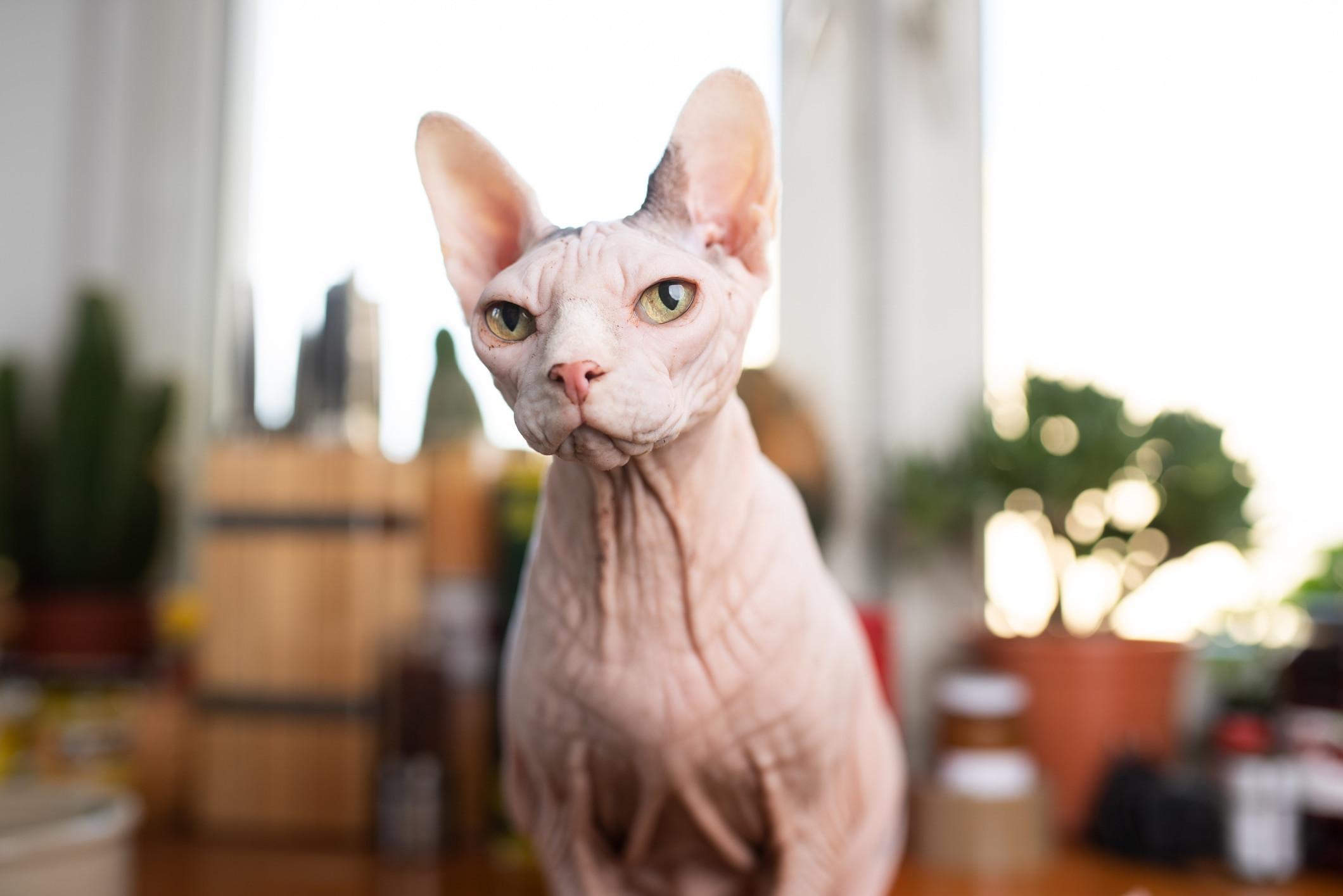 pink sphynx cat looking down at the camera in a living room
pink sphynx cat looking down at the camera in a living room
Photo credit: Nils Jacobi/iStock / Getty Images Plus via Getty Images
Often perceived as entirely nude, the Sphynx cat is actually covered in a fine layer of downy fur. According to April Arguin, a Sphynx breeder and founder of LiLNudists Cattery, the Sphynx’s skin has a chamois-like texture, making them wonderfully warm to touch and ideal for cuddling on chilly days.
While some Sphynx cats may sport whiskers and eyebrows, others lack them entirely. All, however, possess distinctive wrinkles and elongated toes. It’s also worth noting that Sphynx cats are known for being quite vocal and expressive.
2. Bambino
 pink and gray bambino cat licking his lips
pink and gray bambino cat licking his lips
Photo credit: Adobe Stock/Anne Richard
The Bambino is a relatively new addition to the hairless cat family, having emerged in 2005. Currently considered an “experimental breed” by the Cat Fanciers Association, the Bambino is a result of crossing the hairless Sphynx with the short-legged Munchkin cat.
Arguin emphasizes that Bambinos are incredibly people-oriented and crave interaction and attention from their owners. Bringing a Bambino into your home, or even two for companionship as Arguin suggests, means committing to engaging in daily playtime to meet their social needs.
Bambinos come with a significant price tag, typically ranging from $2,000 to $2,800, reflecting their unique and sought-after nature. It’s also important to be aware that due to their Munchkin lineage, Bambinos can be predisposed to joint issues related to their short legs.
3. Peterbald
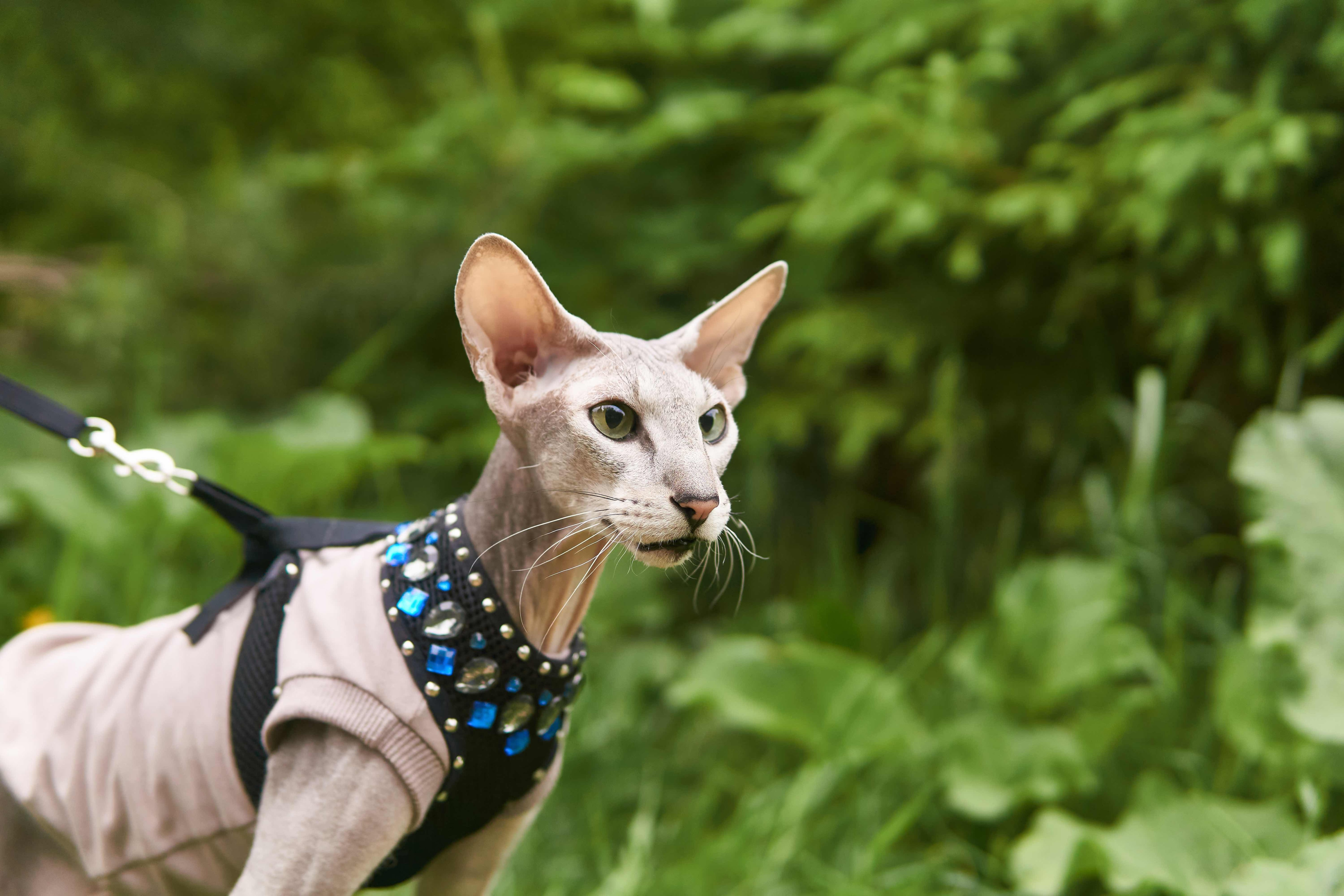 gray peterbald cat wearing a sweater on a leash
gray peterbald cat wearing a sweater on a leash
Photo credit: Adobe Stock/Evgeny
This hairless breed is characterized by its striking ears – large, pointed ears that appear disproportionately big for their wedge-shaped heads. Peterbald cats are relatively rare outside of Russia, but they are known for their friendly and energetic personalities. They often enjoy interactive games like fetch and have a tendency to follow their human companions closely.
Interestingly, not all Peterbalds are completely hairless. The breed exhibits a range of coat variations, from completely bare to fuzzy, curly, or even wiry fur of different lengths. Some Peterbalds can even develop a short or long coat, resembling typical non-hairless cat breeds.
4. Donskoy
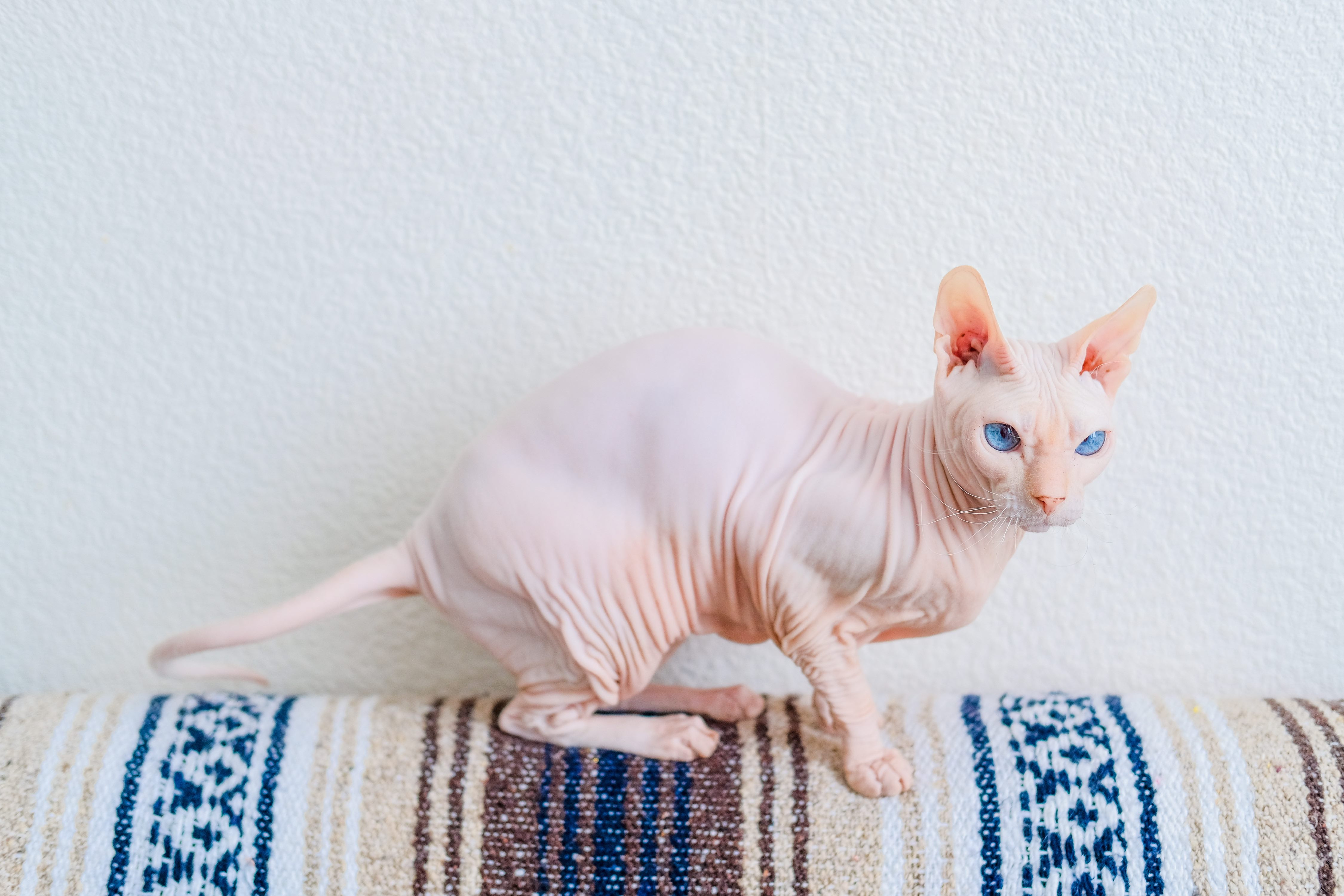 pink hairless cat with blue eyes perched on the back of a couch
pink hairless cat with blue eyes perched on the back of a couch
Photo credit: Adobe Stock/yolya_ilyasova
Donskoy cats are known for their varied levels of hairlessness, categorized into four distinct types:
- Rubber bald: These Donskoys are born completely hairless and remain so throughout their lives.
- Flocked: Born with a soft, downy coat resembling peach fuzz, some flocked Donskoys may eventually lose their fuzz and become bald.
- Velour: These cats are born with a bald patch specifically on their heads.
- Brush: Brush Donskoys have bald patches scattered throughout their coat, creating a unique appearance.
With their affectionate nature and intelligence, the Donskoy makes a wonderful family pet. Their adaptable and friendly temperament often makes them excellent companions for children and other pets within the household.
5. Lykoi
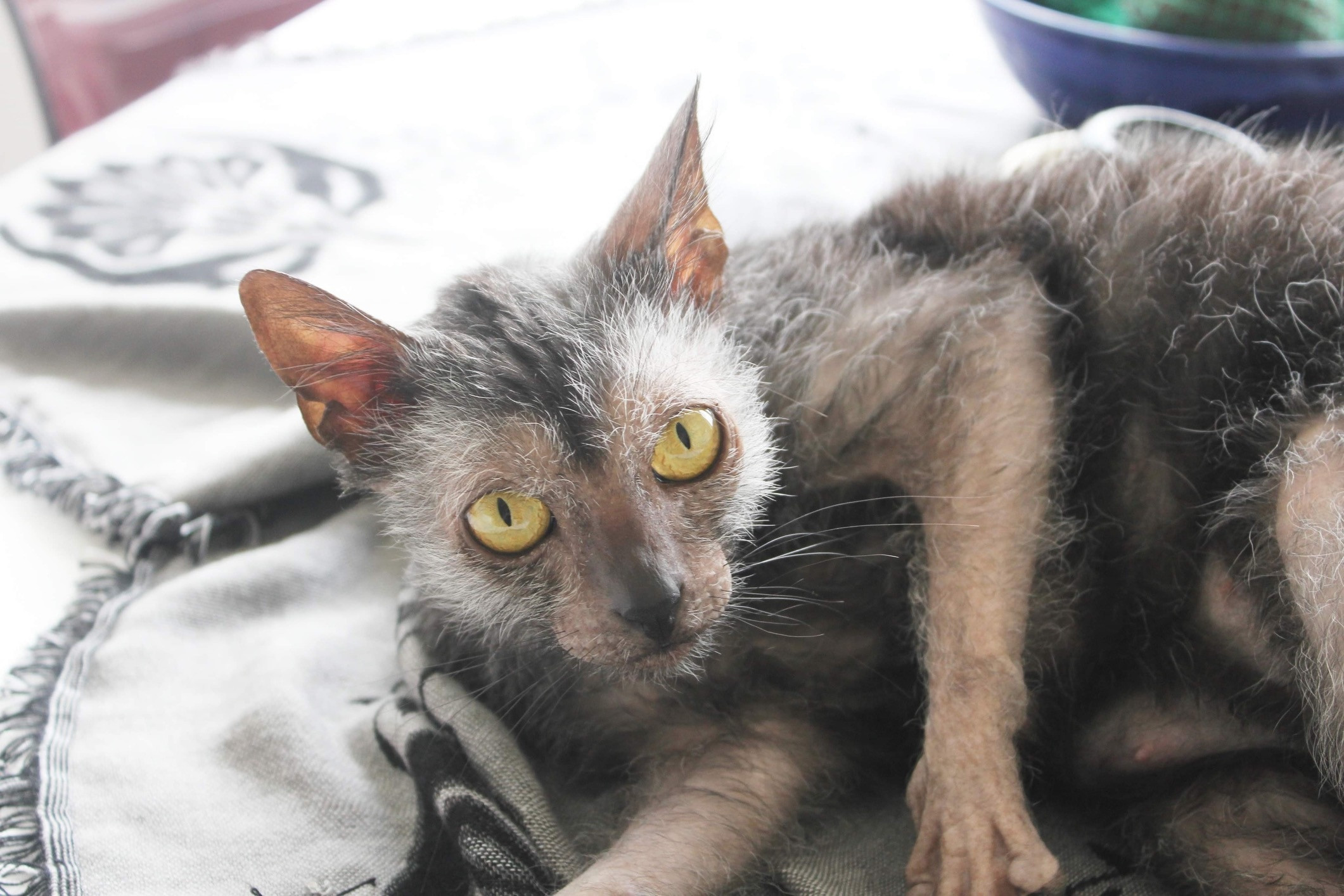 gray lykoi cat lying on his side and looking at the camera
gray lykoi cat lying on his side and looking at the camera
Photo credit: Angela Emanuelsson/iStock / Getty Images Plus via Getty Images
The Lykoi, also nicknamed the “werewolf cat,” is recognized for its sparse and unique coat that periodically molts, a process referred to as “wolfing out.” Despite their somewhat wild appearance, when Lykois do have fur, it is incredibly soft, making cuddling sessions particularly enjoyable. Owning such a distinctive cat comes at a premium, with Lykoi kittens typically starting at around $1,000.
6. Ukrainian Levkoy
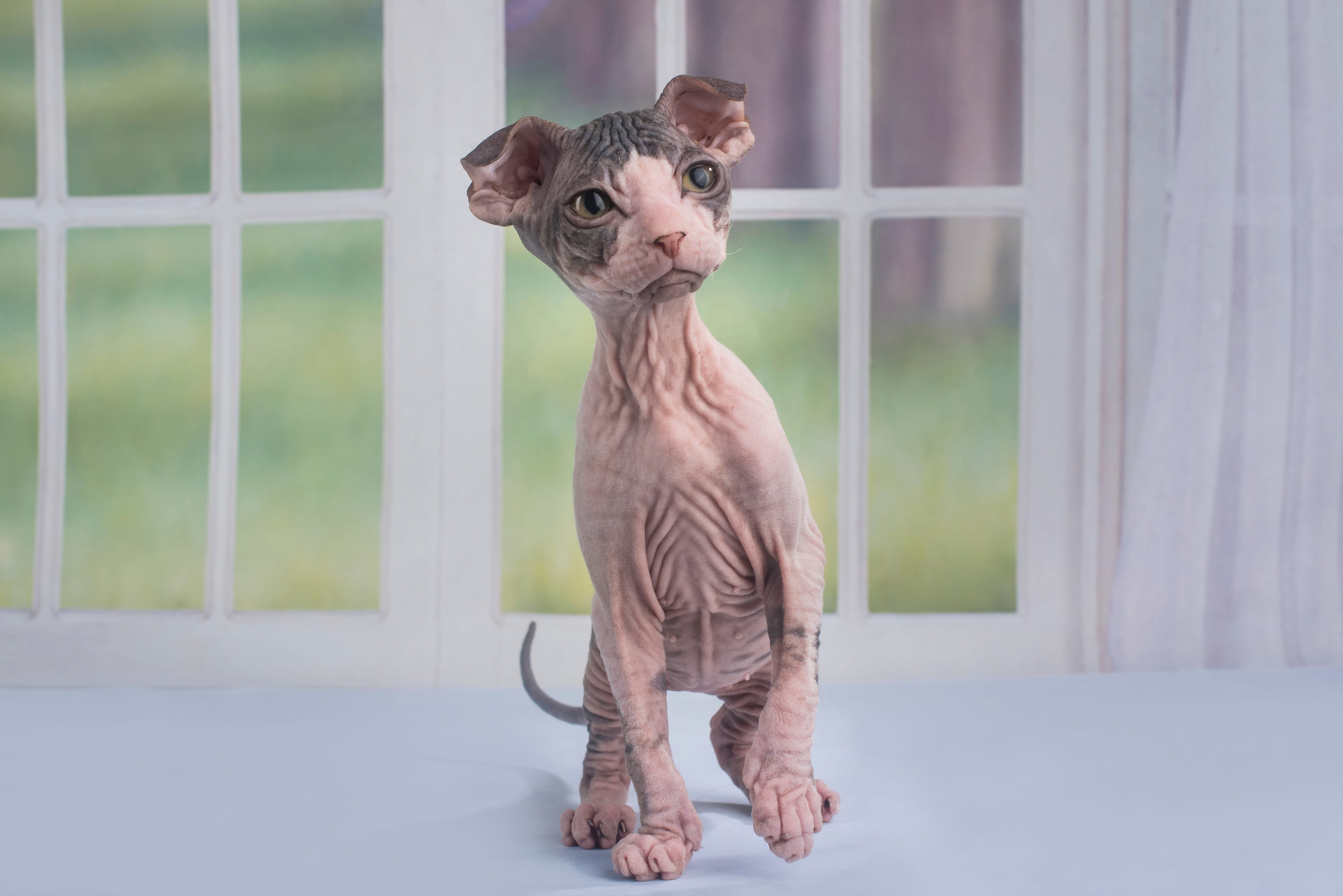 hairless ukrainian levkoy kitten standing in front of a window backdrop
hairless ukrainian levkoy kitten standing in front of a window backdrop
Photo credit: Adobe Stock/Светлана Валуйская
If the folded ears of the Ukrainian Levkoy seem familiar, it’s because this breed shares close ancestry with the Scottish Fold. As the Ukrainian Levkoy is a relatively recent breed, officially established in 2004, comprehensive data on their long-term health is still being gathered. However, given the Scottish Fold’s known predisposition to joint and cartilage problems, similar health considerations may apply to Ukrainian Levkoy cats.
While folded ears are a highly desirable trait, often increasing the kitten’s price to around $2,000, not all Ukrainian Levkoys inherit this gene. Regardless of their ear shape, they are generally known to be calm and contemplative cats, often content in the quiet companionship of their owners.
Essential Care for Hairless Cats
Bringing a hairless cat into your home requires understanding their specific needs. Their lack of fur makes them more vulnerable to sunburn and less efficient at regulating their body temperature compared to furred cats. Protecting them involves measures like applying cat-safe sunscreen, using window UV filters, providing cooling mats during summer, and dressing them in cozy sweaters during colder months.
Hairless cats are prone to developing oily skin. While frequent bathing might seem necessary, it can actually dry out their skin. Consulting with a veterinarian is crucial to establish a proper skincare routine. This might include regular gentle wipe-downs or occasional baths using specialized shampoos designed to replenish their skin’s natural oils. Additionally, hairless cats often require more frequent cleaning of their ears and nails due to increased buildup of wax and oil.
Hairless cat breeds may need a bit more specialized care, but for those prepared to provide it, these extraordinary felines offer a uniquely rewarding companionship.
Hairless Cat FAQs
Are hairless cats hypoallergenic?
The concept of a truly hypoallergenic cat is a misconception. The allergens that trigger reactions are found in a cat’s saliva, urine, and dander, irrespective of fur length. However, hairless cats are often cited as being among the better choices for allergy sufferers due to the reduced amount of dander released into the environment. If you have allergies, it’s always recommended to consult with your doctor about allergy management strategies before bringing any cat into your home.
What is the cost of a hairless cat?
Due to their relative rarity, expect to pay between $1,000 and $2,000 for a hairless kitten. Finding them in shelters is uncommon, but there may be specialized rescue organizations in your region that occasionally have hairless cats available for adoption.
Are hairless cats affectionate?
Like all cats, a hairless cat’s temperament and friendliness are significantly influenced by their socialization experiences as kittens. Early and positive exposure to people, other animals, and various environments helps them develop into adaptable and friendly companions. With proper socialization and positive reinforcement, hairless cats can be just as loving and affectionate as any other cat breed.
WRITTEN BY
Janelle Leeson
Freelance Writer
